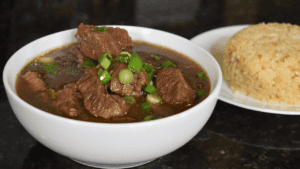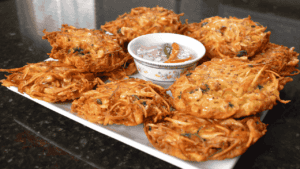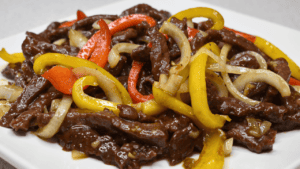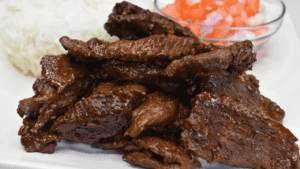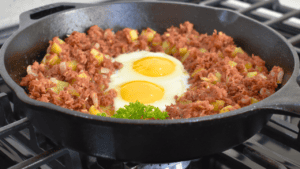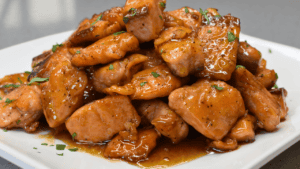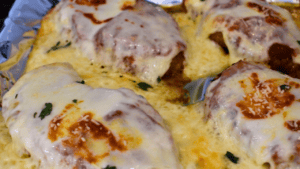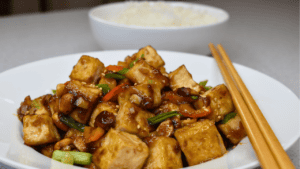Classic Pork Sinigang
Classic pork sinigang is a traditional Filipino soup dish that is loved by many. It is a sour and savory soup made with chunks of pork, various vegetables, and tamarind broth.
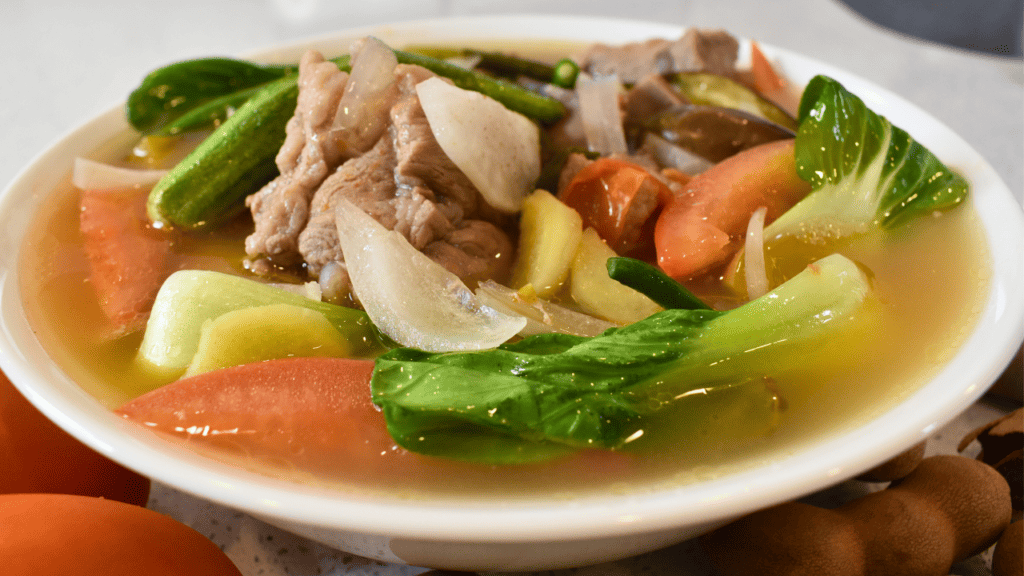
Savor the Soul of Filipino Cuisine with Traditional Pork Sinigang
Discovering Pork Sinigang’s Cultural Essence
For anyone exploring the lush landscapes of Filipino cuisine, pork sinigang is a dish that stands out both in flavor and tradition. This savory and tangy soup has been a staple in Filipino households for generations, celebrated for its unique taste that marries the earthiness of pork with the sharp tang of tamarind. Originating from the Filipino word “sigang,” meaning to stew, sinigang embodies the comforting warmth of home cooking that resonates with many who have tasted it.
Often considered a quintessential Filipino dish, sinigang reflects the diverse cultural influences that have shaped the country’s culinary identity. It’s a meal that brings families together, often enjoyed during gatherings or as a comforting dish on rainy days. Its ability to adapt to various ingredients available in local regions makes it not only a beloved everyday meal but also a representation of the resourcefulness and creativity inherent in Filipino cooking.
In this guide, you will learn how to master the art of cooking classic pork sinigang. From understanding its historical roots to perfecting the recipe in your kitchen, you’ll gain insights into why this dish is cherished, along with practical tips to enhance your culinary skills.
Essential Ingredients and Tools for the Perfect Pork Sinigang
Creating a delectable pork sinigang starts with gathering the right ingredients and kitchen tools. The beauty of this dish lies in its simplicity and the freshness of its components. The traditional ingredients include:
- Pork Spare Ribs (2 lbs): The choice cut of meat that imparts rich flavors when simmered.
- Bok Choy (1 lb), Daikon (150 g), and Eggplant (2 medium) for added texture and nutrients.
- Long Beans (12 pieces), Okra (10 pieces), and Tamarind (10 pieces) that contribute to the distinctive tangy taste.
- Aromatics like Fish Sauce (2 tbsp), Onion (1 medium), Ginger (1 medium), and Tomatoes (2 medium) that enhance the overall flavor.
- Water (8 cups) serves as the base for the broth.
In addition to these ingredients, ensure your kitchen is equipped with a large pot, a sharp knife for chopping, and a strainer to extract tamarind juice. These tools will help you efficiently prepare each component of the sinigang, ensuring a smooth cooking process.
Arming yourself with the right supplies sets the stage for crafting a dish that’s as close to authentic as possible, capturing the flavors and aromas that make pork sinigang a household favorite.
Step-by-Step Guide to Cooking Classic Pork Sinigang
Cooking pork sinigang is an enjoyable process, perfect for both novice and experienced home cooks. Follow these comprehensive instructions to create a dish that’s not only delicious but also deeply rooted in Filipino tradition.
1. Prepare the Broth
Start by boiling 8 cups of water in a large pot. Introduce the chopped pork spare ribs once the water reaches a rolling boil. Reduce the heat to a simmer and allow the pork to cook for about 30 minutes. This step ensures the meat becomes tender and infuses the broth with rich flavors.
2. Infuse with Tamarind
Add the tamarind pieces to the simmering broth. Extract the juice by pressing the tamarind against the sides of the pot, then discard the pulp and seeds. The tamarind juice is crucial in giving the sinigang its signature sourness. Be patient and ensure maximum flavor extraction.
3. Add Aromatics and Vegetables
Introduce the chopped onion, ginger, tomatoes, long beans, eggplant, okra, daikon, and fish sauce to the pot. Simmer these ingredients for an additional 5 minutes, allowing the vegetables to cook until tender. This step melds the flavors together, enhancing the robustness of the dish.
4. Finish with Bok Choy
Finally, stir in the bok choy and simmer for 2 more minutes. This leafy green adds a fresh note and a splash of color to the soup, completing the taste profile of the sinigang. Once done, serve your pork sinigang hot, paired with steamed rice to soak up the flavorful broth.
Exploring Variations and Flavorful Tips of Pork Sinigang
While traditional pork sinigang is a classic, exploring variations can add excitement to your cooking repertoire. Whether it’s adapting the protein or enhancing the flavor, here’s how you can experiment with this beloved dish.
1. Seafood and Beef Sinigang
For seafood lovers, swapping pork for shrimp or fish can create a lighter, yet equally flavorful version. Beef sinigang is another popular alternative, offering a richer taste. Adjust cooking times accordingly to ensure each protein is cooked to perfection.
2. Enhance with Spices
Adding spices such as chili for heat or lemongrass for a citrusy note can customize the flavor profile of your sinigang. Experiment with different herbs and spices to discover unique combinations that suit your palate.
3. Balance the Sourness
If the dish turns out more sour than desired, a pinch of sugar can balance the flavors. Similarly, adjusting the amount of tamarind used can tailor the tanginess to your liking, ensuring each bowl of sinigang meets personal preferences.
Health Benefits of Pork Sinigang
Beyond its delightful taste, pork sinigang offers various health benefits owing to its nutritious ingredients. This section highlights the wholesome aspects of this traditional Filipino soup.
1. Protein-Rich Pork
Pork is a substantial source of protein, essential for muscle repair and growth. The spare ribs used in sinigang provide a hearty dose of this macronutrient, contributing to a balanced diet.
2. Nutritious Vegetables
The array of vegetables in sinigang, such as bok choy, daikon, and eggplant, pack a punch of vitamins and minerals. These components offer dietary fiber, vitamin C, and antioxidants, promoting overall health and well-being.
3. Tamarind’s Health Perks
Tamarind, the key souring agent in sinigang, is rich in antioxidants and has anti-inflammatory properties. It’s known to aid digestion and provides essential nutrients like magnesium and potassium.
Wrapping Up with a Flavorful Pork Sinigang Finish
Pork sinigang is more than just a dish; it’s a celebration of Filipino culinary heritage. By following this comprehensive guide, you’re not just cooking a meal, but also connecting with a tradition that has brought joy to countless tables.
We encourage you to try this classic recipe and share your experiences with us. For more delicious Filipino recipes, explore dishes like Sinigang na Buto-buto, Kare-Kare, Tinola, Pancit, and Best Crispy Okoy. Each offers a unique taste of the Philippines, promising a delightful culinary adventure.
Frequently Asked Questions About Pork Sinigang
How to Cook Pork Sinigang?
Cooking pork sinigang involves simmering pork spare ribs in water, followed by adding tamarind for sourness, and incorporating a mix of vegetables and aromatics. The process is straightforward, with the aim to blend flavors seamlessly.
How Long to Cook Pork?
Simmering pork spare ribs for about 30 minutes ensures they become tender. This step is crucial for developing the rich, savory base that defines pork sinigang.
What is Pork Sinigang Made Of?
Pork sinigang consists of pork spare ribs, a variety of vegetables (such as bok choy, daikon, and eggplant), tamarind for sourness, and aromatics like onions and ginger. These ingredients combine to create a flavorful and nutritious soup.
What is Sinigang Called in English?
Sinigang is commonly referred to as “sour soup” in English, highlighting its distinctive tangy taste.
How Do You Remove Bitterness from Sinigang?
If your sinigang tastes bitter, adding a small amount of sugar can help neutralize the bitterness, balancing the flavors without overpowering the dish’s inherent tanginess.
How to Cook Pork All the Way?
Ensuring pork is fully cooked involves simmering it in water until it becomes tender. Use a meat thermometer to verify that the internal temperature reaches at least 145°F (63°C).
What is the Best Cooking Method for Pork?
Simmering is ideal for pork sinigang, as it allows the meat to release its flavors while absorbing the broth’s tangy essence, resulting in a tender and flavorful dish.
How Do You Make Pork Soft and Tender?
Simmering pork slowly over low heat ensures it becomes soft and tender, allowing the connective tissues to break down and infuse the meat with savory goodness.
How Long Should I Boil Pork?
Boiling pork for approximately 30 minutes is recommended for sinigang. This duration ensures the meat is cooked thoroughly while maintaining its tenderness.
How Do You Keep Pork Moist When Cooking?
To keep pork moist, avoid overcooking and maintain a gentle simmer during preparation. This helps retain the meat’s natural juices, ensuring a succulent result.
How Do I Cook Pork Without Drying It Out?
Simmering pork at a low temperature prevents it from drying out. It’s essential to monitor the heat and cooking time, ensuring the meat remains moist and tender.
How to Tell if Pork is Fully Cooked?
Pork is fully cooked when it reaches an internal temperature of 145°F (63°C). A meat thermometer is the most accurate way to verify doneness.
Explore More Filipino Recipes
Dive deeper into the world of Filipino cuisine with these mouthwatering recipes:
- Sinigang na Buto-buto: A variation featuring bone-in pork for a richer flavor.
- Kare-Kare: A peanut-based stew that’s a beloved festive dish.
- Tinola: A comforting chicken soup with papaya and ginger.
- Pancit: An iconic noodle dish perfect for any celebration.
- Best Crispy Okoy: Delightful shrimp fritters that are crispy and flavorful.
Each recipe offers a unique taste of the Philippines, inviting you to explore the diverse flavors that define this vibrant culinary tradition.
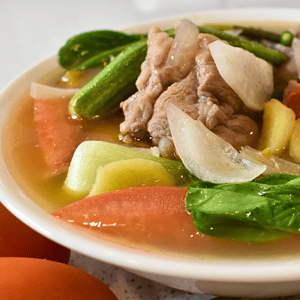
Classic Pork Sinigang
Ingredients
- 2 lbs pork spare ribs chopped
- 1 lb bok choy
- 150 g daikon chopped
- 2 medium eggplant chopped
- 12 pieces long beans
- 2 tbsp fish sauce
- 1 medium onion chopped
- 10 pieces okra
- 8 cups water
- 1 medium ginger chopped
- 10 pieces tamarind
- 2 medium tomatoes chopped
Instructions
- Bring 8 cups of water to a boil in a large pot.
- Add the chopped pork spare ribs and simmer for 30 minutes, allowing the flavorful aroma to fill your kitchen.
- Toss in tamarind pieces, extract the juice, and discard the pulp and seeds.
- Stir in chopped onion, ginger, tomatoes, long beans, eggplant, okra, daikon, and a splash of fish sauce. Simmer for 5 minutes until the vegetables are tender and vibrant.
- Add bok choy and let the flavors meld for another 2 minutes.
- Serve hot with steamed rice and savor every bite of this comforting dish!
